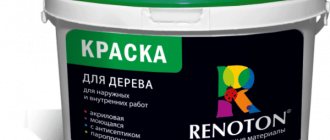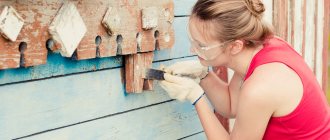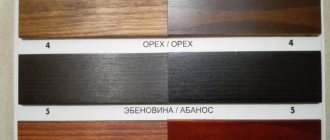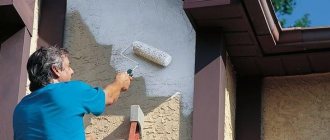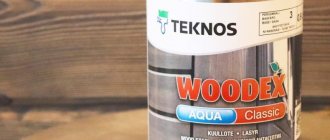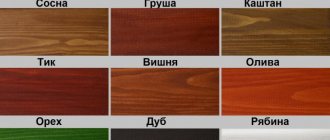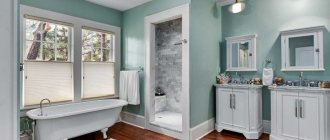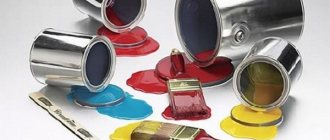Exterior wood paint is an important means of updating and protecting the façade. The high-quality composition will protect against the harmful effects of sunlight and precipitation.
Having chosen a higher-quality composition once, you will have to update it less often, thereby saving on re-application after a few years.
The safety and durability of the facade depends on whether you choose the right coating for treating the outside of your house.
Composition for wood
What paint is better to paint a wooden house
Good paint for facade work should have the following qualities:
- Moisture resistance. Paint for wooden facades forms a protective layer on its surface and prevents the passage of water into it;
- Frost resistance. It is important that exterior wood paint can withstand low temperatures and severe frosts, as well as freeze-thaw cycles;
- It had a UV filter and was not subject to fading or discoloration;
- Wear resistance. Wear-resistant wood paint for exterior use can withstand impacts from falling branches and exposure to chemicals;
- It had antiseptic properties: it prevented the formation of microbes, bacteria, and the establishment of bark beetles in wood.
You can practice at home with your child...
Requirements for facade paints
The house on the site has been built, and now it will protect you from the cold and bad weather. But in order for him to be able to protect you, it is necessary to protect, first of all, himself. Wood is a durable material, but very susceptible to destruction. Rain, frost, and temperature changes will quickly turn smooth boards and rounded logs into a cracked, crumbling mass. In addition, the house must have its own color.
When you see a building, the first thing you remember is its color. And then - how many windows, doors, floors there are. Home painting is like clothing: it decorates and protects. But other wooden structures also need painting. Especially if they are located in the open air: structures on playgrounds, wooden bridges, garages, warehouses, bathhouses, etc.
Conventional coloring compounds will not work here. We need specialized ones that must meet the following requirements:
- Durability. Who needs to repaint a building every year these days?
- Protection of wood from corrosion. The composition must preserve the wood in its original form, preventing cracks, swelling, and shedding.
- The ability to hold color for a long time (usually achieved by the presence of a UV filter). Can you imagine the disappointment of the owner who bought bright purple paint for his house and after a year saw that under the influence of the sun and rain the color had become pale and barely noticeable?
Modern facade paints contain, among other things, antiseptics, fire retardants and water-repellent substances. Oddly enough, anti-corrosion facade coatings were invented quite a long time ago - back in Ancient Rus'. Modern scientists have only refined the technology, but have hardly changed it. The long history of facade coloring mixtures is explained by the fact that in Rus' wood was the main building material due to its abundance in this area. Plus many years of experience in shipbuilding: wooden ships most of all needed external processing.
Rating of the best wood paints for exterior use
The best manufacturers of paints and varnishes for outdoor use are well-known brands.
Although some prefer to make the composition themselves:
If you want to buy ready-made, then this information is for you:
"Belinka" is a company that has been producing paint and varnish materials for more than 30 years. It occupies a leading position in the global market for the production of facade products;
Alpina is the most experienced paint and varnish company in existence for over 100 years. It produces paint and varnish materials for exterior and interior use. Its products are universal. "Alpina" produces compounds to create a protective layer not only on wood, but also on metal and other surfaces;
"Olsta" is a company that creates first-class wear-resistant materials. They do not contain harmful impurities, they are safe;
Premium products of the Dulux brand retain their protective properties in any weather and in any climatic conditions;
"Neomid" (more than 30 years of experience) produces odorless paints.
Does wood need to be painted?
Wood is a very vulnerable material to atmospheric influences.
Various weather conditions, temperature changes, and regular “communication” with moisture negatively affect the condition of facades and structures made from it.
Under the influence of natural phenomena, surfaces lose their visual appeal, begin to grow overgrown with mold, fungi, moss, and cracks appear.
Paint helps to avoid such troubles or correct flaws if you have already encountered a problem.
Wood buildings need a high-quality paint layer in order to:
- repel moisture, prevent its absorption into deep layers of material;
- protect from the settlement of microorganisms in the pores, repel insect pests;
- prevent sun drying and subsequent cracking;
- provide abrasion resistance;
- preserve noble beauty, prolong the life of the structure.
All this is provided by special facade paints, which are not only possible but also necessary to use on wood.
Antiseptics
During the construction period, the wood must be treated with an antiseptic to prevent the appearance of mold. Mold microspores are volatile. They spread easily and quickly in a wooden house, forming more and more new lesions. Mold enters a person’s respiratory tract, negatively affecting his health. Antiseptics are designed to prevent the appearance of mold and mildew and harmful insects in wood. Antiseptics are divided into water-based, oil-based, and solvent-based products. They are intended for external and internal work, for prevention and restoration. Let's look at the best antiseptics.
"Senezh trans"
The most popular antiseptic is: “Senezh”. It is an antiseptic that protects against wood-eating insects, mold and rot. This product does not wash out. Therefore, it can be used in places with high humidity: baths, saunas, cellars. The manufacturer guarantees the high quality and protective effect of the antiseptic for 30 years.
"Neomid 460"
An antiseptic protects surfaces from fungus and mold.
It is actively used for processing boards, timber, logs that come into contact with water and soil in cellars, baths, and bathrooms. Excellent adhesion to any surface. An environmentally friendly product that does not emit toxic substances. "Aquatex"
The material is used for priming wooden surfaces before applying the topcoat. Increases surface adhesion. It provides bioprotection against pathogenic microorganisms and insect pests. Prevents darkening and fading from ultraviolet rays, protects against precipitation.
Causes of wood aging
Wood is a living natural material, which, like humans, requires careful treatment and care. Even after the tree has been cut down and used as a building material, the wood continues to react to the environment in which it is found for many years. It begins to dry out if the environment is dry, or swell if the air humidity is high. Due to uneven drying of the wood, cracks may form at the ends of the log or beam, which will create favorable conditions for infection by destructive microorganisms. Another factor that adversely affects unprotected wood is the environment. Snow in winter, rain and scorching sun in summer - all this leads to the gradual destruction of wood. This natural material is also loved by various insects that actively live in the pores of wood, which also leads to its gradual damage and, ultimately, destruction. And, if a living tree, due to its roots and crown, can independently withstand negative factors, then cut wood requires care and additional protection from humans. Natural oil provides just such protection. It impregnates the wood and prevents the development of processes that could ultimately lead to its destruction.
Acrylic wood paint for exterior use
The most popular are acrylic paint compositions. Their cost is low.
Quick-drying paint has increased moisture resistance and good adhesion. The range of colors is varied, it is important to use colors. Their base is water, the binding component is acrylate. Let's figure out which acrylic paints are most in demand.
"Belinka"
The coloring composition of the Slovenian manufacturer is famous for:
- reliability and safety;
- used for exterior woodwork: painting facades, window frames;
- the painted facade has a smooth, glossy surface;
- After the paint dries, a durable protective layer is formed on the surface. The protective film protects the wood from insects, pests, fungus, mold, and rotting;
- paint for a wooden house improves the natural grain of wood;
- a wide range of shades allows you to emphasize the natural color of wood and give the facade a luxurious appearance;
- The finishing of the house is not affected by ultraviolet radiation. The color remains the same as when painted after many years;
- long service life is an important advantage of Belinka acrylic paint;
- The product is not afraid of exposure to low and high temperatures, or rain.
Toplazur
The disadvantage of Belinka is the high consumption of the composition.
The fact is that wood easily absorbs the product when first painted. In order to paint a wooden facade well, it is necessary to apply 3 layers. The paint layer takes a long time to dry: 6-10 hours. To ensure that the surface is painted evenly and does not differ in color, so that joints are not visible, the entire facade must be treated.
"Alpina"
This German-made coloring composition confirms its high quality with the appropriate Certificate. It is intended for facades and terraces.
- the coloring composition is wear-resistant;
- prevents the passage of moisture into the wood;
- the elasticity of the composition resists vibrations and protects against the formation of cracks in the wood during shrinkage;
- due to high vapor permeability, condensation does not form, fungus and mold do not appear;
- the product is characterized by low consumption of the composition during surface painting;
- When using it, it is possible to tint the façade surface in any color you desire.
An important disadvantage of the paint and varnish material is the high price and the possibility of streaks appearing after rain.
"Olsta"
The acrylic paint product has a smooth, streak-free surface. Exterior wood paints are produced in Finland. Paint and varnish products are bottled at a Russian plant in Tver. Finnish equipment and technology help Russian industry produce high-quality products at a low price.
- it is safe, does not contain harmful substances and chalk;
- it is anti-allergenic and does not cause allergic reactions;
- resistant to physical stress;
- does not wash off;
- composition consumption is economical;
- it contains antiseptic additives that prevent the formation of rot, mold and mildew;
- intended for wooden facades, treated and untreated plank surfaces;
May be interesting: How to cover the ceiling of a wooden house inside cheaply and beautifully
"Liberon"
Manufacturer: France. It arose back in the 19th century. Painting with premium products gives woodwork new life. The street appearance of the frames and façade after painting with Liberon is luxurious. Every year the company develops a new range of products. The paint forms a durable protective layer.
How to determine consumption
Manufacturers indicate on the packaging surface the norm for product consumption on a flat surface. Paint for wooden walls is developed taking into account the absence of various defects.
It is recommended to pre-coat the structure with a primer mixture that reduces the volume of pores in the wood structure. As a result, it is possible to significantly reduce the volume of decorative material.
How to determine the amount of paint material? Several recommendations have been developed for this.
They are as follows:
- Density of wood base. Solid pine, birch and maple have a high degree of absorption. Natural oak and ash have a finely porous surface;
- Wood fiber texture. If the walls of the facade are made of smooth material, then a minimum amount of paint and varnish solutions will be required for work. For rough surfaces, paint consumption will increase significantly;
- Complexity of design. During the processing process, do not forget about hard-to-reach areas that require special attention;
- A type of dye. As noted above, oil types of paint are characterized by minimal consumption; acrylic and alkyd dyes require preliminary priming;
- Work tool. For example, using a spray gun, the volume of dye is significantly reduced than when working with a regular brush.
Alkyd paint
Alkyd paint compositions have a glossy surface that gives it an attractive appearance. The paint consists of film formers: latex and resin. The coloring composition also includes pigments, solvent, fillers, and additives that give the paint elasticity. A feature of alkyd paints is their uniform application to the surface and rich color. After painting, a thin film is formed on the surface, protecting it from external influences.
The paint has low frost resistance and vapor permeability. The surface does not breathe, does not allow air to pass through. Alkyd paints have a pungent odor that persists even after drying. A primer should be applied before painting.
"Tekc pro"
- the product is used for any premises;
- is highly resistant to water;
- harmful microorganisms: mold and mildew. Penetrates deeply into the surface of the wood, affecting bugs and protecting it from putrefactive processes;
- The product is resistant to chemicals. To wash walls and floors painted with this paint, you can use any detergent;
- has no smell;
- A wide range of shades helps you choose the color of your choice. No tinting required;
- The protective layer is durable.
The disadvantages of paint include high consumption and long drying time. When painting a smooth surface, smudges may occur.
"Tikkurila empire"
- water-alkyd based dye contains bioprotective substances;
- resistant to water, temperature changes, friction, chemicals. The painted surface can be washed with abrasives and sponges, nothing will happen to it. It will retain its smoothness, strength and other positive properties;
- it does not emit harmful fumes, therefore it is suitable for children's institutions and medical centers. Anti-allergenic;
- painting with it is easy and pleasant because it does not smell;
- quick drying, low consumption will save money and time on painting.
"Vincent A-3"
- alkyd-based enamel forms a highly durable glossy coating;
- the protective layer saves the tree from early rotting;
- semi-matte shine emphasizes the natural structure of the wood;
- paint surfaces in 2-3 layers. The low consumption of the composition allows you to save the family budget, while at the same time updating the wooden covering;
- The product applies easily, painting evenly on any wooden surface.
The disadvantage is low wear resistance: it fades from bright sunlight and cracks from temperature changes.
Painting wood (step by step instructions)
Painting wood is not difficult; it is important to follow certain rules.
- Paint is applied only to a thoroughly dried surface.
- It is better to start painting from the corner, if these are walls, floors or ceilings.
- The paint is applied with vertical strokes, after which it is thoroughly rubbed with horizontal movements.
- When applying the first layer, the solution can be slightly diluted so that it adheres better. To create a reliable base, the surface is covered with a second layer. After the secondary painting, the defects are sanded and painted a third time.
- Large volumes are painted with a spray gun. This professional equipment provides high quality paint application using spraying. However, if the painting area exceeds 50 m2, then sagging will form. Even if a master of his craft will paint with this tool.
It is very important that the distance between the surface and the painting equipment remains the same, and the speed of the sprayer is uniform.
When painting you should remember:
- The air temperature during painting should be more than +5°C.
- Before use, it is recommended to rinse brushes or brushes in water with detergent.
- Work should not be carried out under the scorching sun or strong wind.
- For safety reasons, personal protective equipment is used.
The wide range of application of wood paints and their versatility will give a high-quality result only if the work technology is fully followed.
Oil paint
Oil paint has high adhesion to the surface. But it smells unpleasant and can give you a headache when painting. The smell does not disappear for a long time. Oil-based paints typically take a long time to dry. It is better to paint in dry weather. It quickly fades from ultraviolet radiation and changes its color. It is best to use a light-colored oil-based paint product. Its burnout is not so noticeable on it. It has a short service life of less than 7 years.
"Lacra MA-15"
The coloring composition is intended for external and internal use, for application to wooden and metal surfaces. To make the surface shiny and attractive, it is important to prepare it for painting: remove the old layer, remove uneven surfaces, and prime it. The composition is wear-resistant, forms a protective layer from external influences. It takes a long time to dry.
"Tikkurila teho"
Coloring agent that meets international quality standards.
- an important indicator of the coloring composition is its hiding power;
- it is intended for processing plank surfaces, fences, facades;
- high elasticity, strength contributes to paint durability, long service life of 7 years;
- The color palette is varied. It covers 120 colors and tones of the spectrum;
- It dries in 2-4 hours. When painting, it does not leave smudges.
"Teknos Wintol"
- high quality paint. Despite the high price, it is popular among buyers;
- does not discolor when exposed to sunlight;
- It is laid on the surface of the facade in an even layer, evenly distributed over it. Specialists from construction companies use a product for painting premium surfaces;
- the product does not change its properties under the influence of precipitation and temperature changes.
- The 30-year warranty and positive reviews about it allow you to be convinced of its reliability. Manufacturer: Finland.
What type of wood paint is best?
“Which paint to choose for wood?” is a question many homeowners ask. The choice depends on many factors: microclimate, wood structure, purpose of the room. You should pay attention to the region of operation (warm or cold) and what negative impacts the façade of the house will be exposed to.
When choosing, you should not pay attention to the smell, long drying time, or environmental friendliness. The harmful layer will quickly evaporate under the influence of external conditions. It is important to pay attention to the service life of the substance, its wear resistance and strength.
It is important to choose the material strictly individually.
The best type of paint is acrylic.
They are wear-resistant, dry quickly, have good adhesion and an attractive appearance.
How to paint over old paint
People often ask whether it is possible to paint over an old layer. Professionals do not recommend applying a coloring composition to the old coating, because if it comes off, the new layer will also suffer. If the top layer of paint is light, then dark spots of the previous coloring matter that previously covered the facade may appear through it. In addition, not all colors are suitable for each other. The composition will be difficult to apply, adhesion with old paint is low.
In some cases, it is easier to sheathe a house than to repaint it. Finishing with siding is the most common budget option.
You can paint over the previous layer if it is perfect and does not lag behind the surface. Similar paints and varnishes are applied to the old layer. For oil paint, an oil composition or alkyd enamel is suitable. Sometimes you can use an acrylic paint without removing the old layer, but the surface should be primed. To apply oil paint to oil paint, you should remove the gloss, sand the surface and only then paint.
Water-based paint will adhere to glossy paint only if a primer is applied or the surface of the old coating is sanded. This is necessary in order to ensure high adhesion of surfaces to each other. It is not recommended to paint with oil paint on nitro enamel, because bubbles and cracks will form on the new layer, which will lead to peeling and disruption of the aesthetics of the layer.
Technological process of painting
Having decided on the type of paint, and having appointed the day on which the finishing will be carried out, it is necessary to go through the preparatory stage before the actual painting. It consists of cleaning the surface of the walls from the old paint and varnish coating, if any . To do this, use special solutions or a hair dryer.
If there are none, then the process can be carried out in the usual way, using a spatula or a wide chisel. As for the new structure, it is necessary to treat it with a solution with an anti-tar effect.
To prepare the surface of an old building, you will need to use putty, which will be used to repair the cracks and chips that have formed. After waiting for the material to dry completely, the areas covered with it are sanded.
Padding
This process begins with washing the walls using a soap solution. After waiting for the wooden facade to dry completely after washing, proceed directly to priming. For this process, a primer containing antiseptic substances is used.
This can protect the tree from water getting into it, which later leads to the formation of mold. After the primer has been applied, you must wait for it to dry completely and continue with the façade finishing.
IMPORTANT!
It is recommended to prime a wooden façade using a brush.
Basic painting work for a wooden house
The process of direct painting should begin only after several days, after priming the surface of the walls.
- Pre-unpack the paint and dilute it to the desired consistency . Depending on the type of materials, the appropriate solvent is used;
- then proceed to apply the first layer, using a brush for this;
- paint is applied to the façade using a roller or sprayer . This can be done either in a single layer or in two or three layers. It takes at least 4 hours to dry one layer of material.
NOTE!
It is advisable to carry out all work on painting the facade at a temperature ranging from - 5 to + 40 degrees.
Useful tips
- If there are metal parts on the facade, then before priming they should be coated with an oil or alkyd composition.
- The wood must be protected with several impregnations before painting, last but not least with a water-repellent agent.
- After the impregnation has dried, the wood is sanded to smooth out the rough surface.
- To remove old paintwork from a wooden surface, use a wire brush, sandpaper, spatulas, or the tool presented in the video above.
Correctly chosen paint for wood for exterior use will create favorable conditions for the durability of the facade. Its pleasant appearance and long service life will delight you for many years.
Criterias of choice
To choose high-quality paint, experts advise based on the following characteristics:
- Manufacturer. It is better to choose proven companies with an impeccable reputation. The compositions of two popular brands from Finland, which are included in this rating, performed well.
- Shelf life. This characteristic should be checked without fail, since after some time the paint loses its properties.
- Price. Expensiveness is not always an indicator of quality, but there is no need to choose too cheap paints.
- Specifics of the structure. It makes sense to take into account the characteristics of the material used for cladding if the house was not built from wood.
- Preparation. For any composition there are specialized primers and impregnations.
About mistakes in painting a wooden house - in the video:

